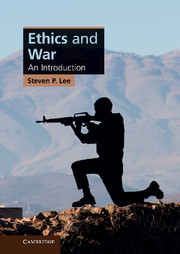Book contents
- Frontmatter
- Contents
- Figures and tables
- Preface
- 1 Understanding war in moral terms
- 2 The just war tradition: a brief history
- 3 When is it just to go to war?
- 4 Sovereignty and human rights
- 5 How should war be fought? Part one
- 6 How should war be fought? Part two
- 7 Civil wars
- 8 Justice at the end of war
- Bibliography
- Index
5 - How should war be fought? Part one
Published online by Cambridge University Press: 05 June 2012
- Frontmatter
- Contents
- Figures and tables
- Preface
- 1 Understanding war in moral terms
- 2 The just war tradition: a brief history
- 3 When is it just to go to war?
- 4 Sovereignty and human rights
- 5 How should war be fought? Part one
- 6 How should war be fought? Part two
- 7 Civil wars
- 8 Justice at the end of war
- Bibliography
- Index
Summary
It is occasionally lawful to kill the innocent not by mistake, but with full knowledge of what one is doing … This is proven, since it would otherwise be impossible to wage war against the guilty, thereby preventing the just side from fighting.
Vitoria… for we know enough, if we know we are the king’s subjects: If his cause be wrong, our obedience to the king wipes the crime of it out of us.
William ShakespeareThe morality of war is divided into two parts, jus ad bellum, concerning when a state may fight, the initiation (and continuation) of war, and jus in bello, concerning how it should fight, the conduct of war. The two parts are usually seen to represent a moral division of labor: jus ad bellum is relevant mainly to leaders, and jus in bello is relevant mainly to the combatants. The rules for leaders are the ad bellum criteria discussed in the last two chapters. In this chapter and the next, we consider the in bello criteria, the rules for combatants. There are three basic in bello rules: the principles of discrimination, proportionality, and due care. Each of these principles is a necessary condition, and a military action in war is justified only if it satisfies all three. A consequence of adherence to the in bello rules is the limitation of the violence of war, not only through reducing the extent of human suffering while war goes on, but also through facilitating the subsequent establishment of peaceful relations between the belligerents. But some in bello rules may have a moral foundation independent of their efficiency in limiting the violence.
The war in Afghanistan: the Bala Baluk episode
Shortly after the terrorist attacks of September 11, 2001, the United States went to war against Afghanistan to overthrow the Taliban regime, then in power over most of the country, which had been harboring al-Qaeda, the organization responsible for the attacks. Working with insurgent forces already battling the Taliban, the United States and Britain quickly overthrew the regime. US forces remained in Afghanistan, joined by forces from other member states of NATO (North American Treaty Organization), to stabilize the new regime they helped to put in power. The occupation continued into the next decade, although the main focus of attention for the United States for much of that time shifted to the war in Iraq. The Taliban were never completely subdued, in part because they had safe haven next door in the “lawless” tribal regions of Pakistan, and their insurgency against the Afghan government grew. Because the number of NATO troops was relatively small, given the large size of the areas in which Taliban insurgents were active, the troops, in their engagements with the insurgents, relied heavily on close support air strikes (air strikes in support of ground troops in battle).
- Type
- Chapter
- Information
- Ethics and WarAn Introduction, pp. 154 - 199Publisher: Cambridge University PressPrint publication year: 2011



